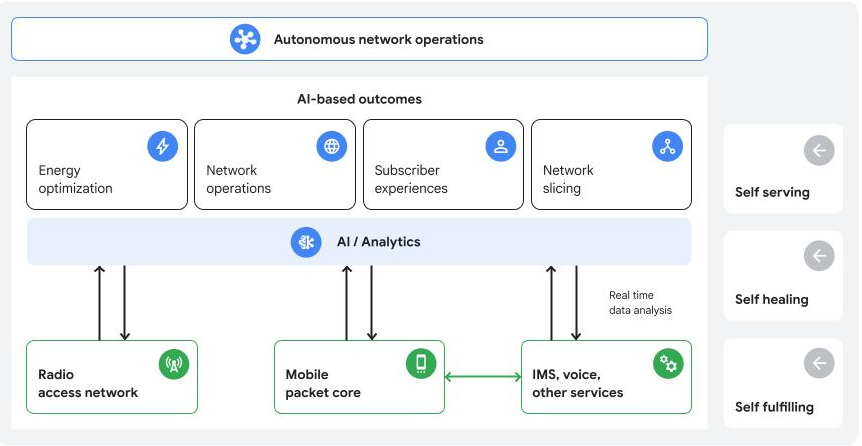Rethinking 5G: The cloud imperative
Eric Parsons
Head of Emerging Segments, Business Area Cloud Software and Services, Ericsson
Muninder Sambi
VP, PM and GM, Networking, Google Cloud
The telecommunications industry is at a critical juncture. The demands of 5G, the explosion of connected devices, and the ever-increasing complexity of network architectures require a fundamental shift in how networks are managed and operated.
The future is autonomous — autonomous networks driving efficiency and innovation
The future isn't just about scale and performance; it's about autonomous networks. Operators can make a transformative leap over their existing automation tools by leveraging the power of AI to significantly boost productivity, profitability, and unlock entirely new business opportunities.
Autonomous network operations (ANO) is becoming a necessity for telecom operators to remain competitive and deliver the “always on, always performant, always secure” experience for the mobile networks that their customers demand. Furthermore, for critical infrastructure like mobile networks that are handling highly sensitive customer data and facing increasing cyberattacks, AI-based technologies are crucial for bolstering security and protecting critical infrastructure.


Autonomous networks require rich data
Realizing the transformative potential of autonomous network operations for mobile networks hinges upon access to rich, granular mobile-network telemetry data. Mobile networks generate vast amounts of telemetry that can be leveraged to improve processes, personalize experiences, and develop new products and services.
The ability to collect, aggregate, and analyze telemetry from diverse sources like RAN, mobile core, and other functions is therefore becoming more and more critical. And it requires a robust data model that can bring together information from these multiple sources and provide the context that AI algorithms need to learn, adapt, and optimize network outcomes in real-time.
For example, AI can enable dynamic network optimization, drive energy efficiency, provide proactive threat detection and personalized service offerings, and predict customer churn. To succeed in these areas often requires training AI network agents on good quality data from these relevant sources.
To effectively harness AI and the vast datasets required for achieving full autonomy, it is essential to unlock the scalability, flexibility, and processing power necessary for these processes.
5G networks must transform for full autonomy
Telecom service providers designed and built on-premises networks over decades to meet stringent regulatory standards, and to deliver carrier-grade scale, performance, and reliability. For autonomous operations to deliver on new outcomes, they require a dynamic environment that can effectively harness new AI models, as well as provide the flexible processing power necessary to train these models using massive amounts of telemetry data.
For example, an operator can quickly expand from fast failure recovery to network optimization using the same telemetry data to train different AI models. The cloud then provides infrastructure for mobile operators to access cutting-edge Cloud TPUs and GPUs that are optimized for AI, global availability, scale, elasticity, and cloud-native AI services. The cloud also supports the rapid pace of innovation that operators require for autonomous operations.
Recognizing this, telecom operators have embraced the cloud to run their mobile networks. However, the initial approach of simply lifting and shifting existing on-premises systems to the public cloud has fallen short of expectations. This approach has often increased operational complexity and hinders the agility necessary for AI-driven network operations.
Bridging the gap to autonomous 5G
Delivering on the promise of "always on, always performant, always secure" mobile networks requires more than incremental change, and operators are looking at mobile core vendors and cloud providers to create a path that unlocks the full potential of AI and data-driven intelligence for them.
Ericsson and Google Cloud are collaborating to drive a fundamental shift in how mobile core networks are built and operated on public cloud infrastructure. Together, we’re working on evolving the packet core technology stack to run on autonomously operated Google Cloud infrastructure that is engineered for reliability and scale.
The companies continue to combine their expertise on multiple fronts — technology innovations, streamlined delivery models, and, most importantly, a shared culture of relentless innovation — to empower operators in realizing their vision of autonomous networks.
5G built right for autonomous networks
The transformation to full autonomy will shape the success of telecom operators — and the cloudification of the 5G mobile core network is a key enabler in that journey. Ericsson and Google Cloud are committed to empowering this transformation.
Ultimately, this transformational approach helps future-proof operator investments, paving the way for a transition to next-generation technologies like 6G and spurring the future of mobile connectivity. Together, Ericsson and Google Cloud are ushering in a new era in mobile connectivity.
We're excited to share more details on this journey later this year, so stay tuned.


